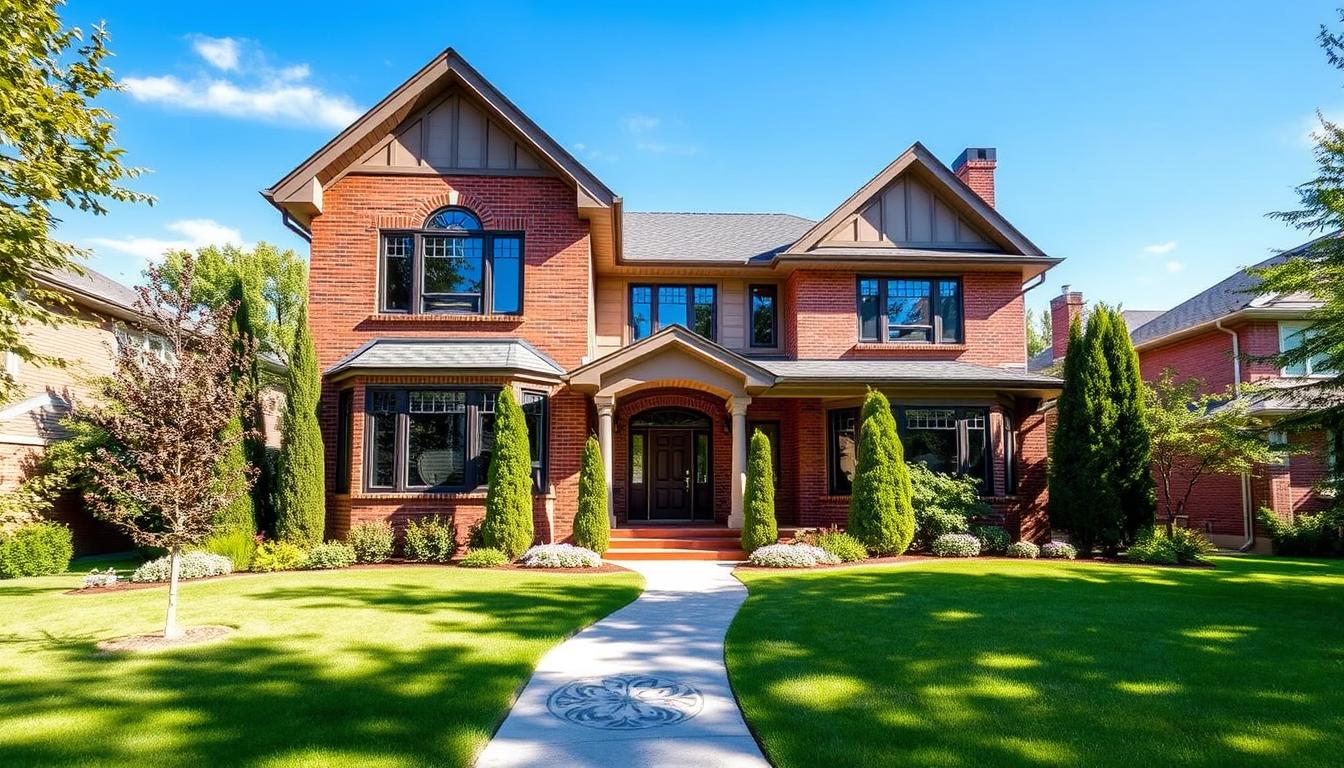
Second Mortgage Calgary
When accessing funds against your property, one metric stands out: the relationship between existing financing and your home’s worth. This figure helps lenders assess risk while giving homeowners clarity on available equity. For those considering additional financing options, it’s essential to grasp how this calculation works.
The formula divides outstanding balances by the current appraised price. For example, a $400,000 home with a $300,000 mortgage would yield a 75% result. Higher percentages often trigger stricter requirements, like mandatory insurance for ratios exceeding 80% – a common scenario in Calgary’s dynamic market.
The Second Mortgage Store in Calgary (+1 403-827-6630) specializes in helping residents navigate these calculations. Their team explains how improving this percentage can unlock better rates or larger loan amounts. Practical strategies might include property upgrades or accelerated principal payments.
This article breaks down key terminology, demonstrates real-world math, and shares actionable tips. You’ll also find regional data showing how local trends impact borrowing decisions. Whether you’re refinancing or exploring investment opportunities, understanding these fundamentals ensures smarter financial choices.
Key Takeaways
- This percentage reflects borrowing risk and available equity
- Higher figures may require additional insurance coverage
- Calgary homeowners can leverage professional guidance for optimal results
- Strategic improvements to property or payments enhance flexibility
- Local market conditions directly influence lending criteria
Introduction to Loan-to-Value Ratios
Your property’s financial potential hinges on a critical metric that lenders scrutinize closely. This percentage determines how much equity you can access and shapes borrowing options. For homeowners exploring refinancing or additional financing, grasping this concept unlocks smarter decisions.
Defining LTV and Its Components
The calculation compares outstanding balances against a property’s current worth. Using the formula (Mortgage Balance ÷ Appraised Value) × 100, a $450,000 balance on a $600,000 home yields a 75% result. Financial agencies emphasize this figure reflects both risk and opportunity. Higher percentages often mean stricter requirements, while lower numbers signal stronger equity positions.
Why LTV Matters in Mortgage Lending
Lenders prioritize this metric because it directly impacts their risk exposure. Ratios above 80% typically require default insurance, adding costs for borrowers. Conversely, figures below this threshold may qualify for better rates or terms.
“A 57.9% national average shows most Canadians maintain healthy equity,”
notes a mortgage specialist from The Second Mortgage Store. Their team helps clients optimize this percentage through strategic planning.
Understanding these dynamics prepares you for discussions about second financing options. Later sections will explore how local trends and property improvements influence these calculations.
The Role of LTV in Securing Second Mortgages
Property owners exploring supplementary funding options often discover their equity position dictates available opportunities. Lenders evaluate this metric to determine how much money they can safely extend while managing their risk exposure.
Borrowing Capacity and Equity Thresholds
Most financial institutions cap combined financing at 80% of a property’s appraised value. Subtract your first mortgage balance from this limit to find accessible home equity. For instance:
- $600,000 current property valuation
- $420,000 remaining on primary mortgage
- Maximum allowable total debt: $480,000 (80% of $600k)
- Available equity: $60,000 ($480k – $420k)
This example shows how tighter ratios reduce borrowing potential. The Second Mortgage Store helps clients interpret these figures, often identifying overlooked equity sources.
Mortgage Types and Lender Requirements
Conventional mortgages typically require ratios below 80%, while high-ratio options exceed this threshold but mandate insurance. Consider how these differences affect your options:
| Factor | Conventional | High-Ratio |
|---|---|---|
| LTV Limit | ≤80% | 80.1%-95% |
| Insurance Needed? | No | Yes |
| Interest Rates | Lower | Higher |
Higher ratios may limit lender choices and increase interest rates. Recent data shows 65% of Canadian homeowners maintain ratios below 50%, creating favorable conditions for accessing home equity through secondary financing.
“Strategic planning transforms equity into opportunity – our team maps each client’s unique financial landscape.”
Understanding these dynamics helps borrowers negotiate better terms. Maintaining ratios below key thresholds often unlocks preferred rates and flexible repayment options.
Understanding what is loan to value ratio second mortgage calgary
Calgary’s real estate climate directly shapes how homeowners leverage their equity. Local shifts in home value create opportunities or challenges when accessing additional financing. A recent 3% quarterly price fluctuation in typical neighborhoods demonstrates why staying informed matters.
Why Local Equity Positions Matter
Market volatility affects appraised value assessments, which lenders use to determine borrowing limits. Consider a $550,000 property that gains $20,000 in market value:
| Equity Increase | New LTV (70% First Mortgage) | Available Second Mortgage Funds |
|---|---|---|
| $20k | 68% → 64% | Up to $34,000 additional |
| $40k | 68% → 60% | Up to $64,000 additional |
This table shows how incremental gains improve financial flexibility. The Second Mortgage Store notes:
“Calgary’s 2023 market saw 22% of homeowners increase usable equity by 15% through strategic reappraisals.”
Regional trends reveal why proactive management matters. With 91% of Canadian properties maintaining LTVs below 75%, maintaining competitive ratios becomes crucial for accessing preferred rates. Local experts like The Second Mortgage Store (+1 403-827-6630) help residents navigate these shifts through customized equity reviews.
Next, we’ll break down exact calculation methods to assess your position accurately.
Calculating Your Loan-to-Value Ratio
Determining your financial position requires precise math. This process reveals how much equity you hold and what financing options become available. Follow these guidelines to assess your standing accurately.
Step-by-Step Calculation Methods
Start by gathering two essential numbers: your remaining mortgage balance and the property’s current worth. Use this formula:
- Divide outstanding loan amount by appraised value
- Multiply by 100 to get percentage
Consider a $350,000 home with $270,000 owed:
| Component | Amount |
|---|---|
| Appraised Value | $350,000 |
| Mortgage Balance | $270,000 |
| LTV Ratio | 77.1% |
Many homeowners mistakenly subtract down payments from current value. Focus only on remaining debt versus present worth. Market shifts can alter this percentage monthly – regular checks prevent surprises.
“A 5% value increase dropped my client’s ratio from 82% to 76%, saving $4,200 in annual insurance costs.”
Lower ratios often unlock better rates. For example, dropping from 85% to 75% might qualify you for conventional loans without mandatory insurance. Track your property’s worth through recent sales data or professional appraisals to maintain accurate figures.
Strategies to Improve Your LTV Ratio and Home Equity
Boosting your property’s financial leverage starts with smart equity management. Two proven approaches – reducing existing debt and enhancing property worth – can reshape your borrowing potential. Let’s explore practical methods supported by market data and expert insights.

Paying Down Your First Mortgage
Accelerating payments on your primary loan directly lowers outstanding balances. This action shrinks the debt portion of the LTV equation, creating immediate equity gains. Consider these impacts:
- A $300,000 home with $240,000 owed has 80% LTV
- Paying $20,000 principal reduces the ratio to 73%
- New borrowing capacity increases by $21,000 (7% equity shift)
Recent data shows homeowners who allocate 10% extra monthly toward their first mortgage reduce repayment timelines by 6 years on average. The Second Mortgage Store notes:
“Every extra dollar paid toward your principal strengthens your financial position.”
Increasing Home Value through Renovations
Strategic upgrades can elevate your property’s appraised worth. Focus on high-return improvements like:
- Kitchen remodels (75-85% cost recovery)
- Energy-efficient windows (68% ROI)
- Finished basements (70% value retention)
A $15,000 bathroom renovation might boost home equity by $25,000 in competitive markets. This 66% value increase directly improves your LTV percentage. Professionals at The Second Mortgage Store (+1 403-827-6630) help clients identify projects aligning with local buyer preferences.
Combining these strategies creates compounding benefits. Lower ratios unlock better rates, while increased equity expands financial flexibility. For customized plans matching Calgary’s market dynamics, consult mortgage specialists to maximize your property’s potential.
LTV Ratios and the Canadian Mortgage Landscape
Canada’s financial regulations create specific benchmarks that shape borrowing conditions nationwide. Understanding these rules helps homeowners make informed decisions while navigating financing options.
Mortgage Default Insurance and LTV Limits
Borrowers crossing the 80% equity threshold face mandatory default insurance. This protection safeguards lenders against payment defaults but adds to the cost of financing. Recent data shows insurance premiums range from 2.8% to 4.5% of loan amounts for high-ratio agreements.
Amortization periods directly influence repayment strategies. Insured mortgages cap repayment timelines at 25 years, while conventional options extend to 30 years. This difference affects monthly payments and total interest rates paid over time.
| Factor | Insured Mortgage | Conventional |
|---|---|---|
| LTV Limit | Up to 95% | ≤80% |
| Insurance Cost | 2.8-4.5% | None |
| Max Amortization | 25 Years | 30 Years |
“Cliften’s save $11,000 annually by restructuring their financing below the 80% threshold,” shares a strategist from The Second Mortgage Store. “Timely equity reviews prevent unnecessary insurance expenses.”
Higher ratios often lead to stricter income verification and elevated risk assessments. A 2023 report revealed borrowers with 90% LTV paid 0.75% higher interest rates compared to those at 70%. Partnering with experienced professionals helps optimize these financial variables while maintaining compliance with national guidelines.
Exploring Alternative Home Equity Options
Homeowners have multiple pathways to leverage property equity beyond traditional financing. Understanding different financial products helps match solutions to specific needs while managing risks effectively.

Flexible Credit Solutions
Home equity lines of credit (HELOCs) function like revolving accounts, letting borrowers access funds up to 65% of their property’s value. Key features include:
- Variable interest rates (currently averaging 6.5-9.3% in Canada)
- Interest-only payments during draw periods
- Credit score requirements starting at 650
In contrast, home equity loans provide lump sums with fixed repayment terms. These often suit planned expenses like renovations or debt consolidation.
| Feature | HELOC | Lump-Sum Loan |
|---|---|---|
| Funds Access | As needed | One-time |
| Interest Type | Variable | Fixed/Variable |
| Fees | Annual ($25-$100) | Origination (1-5%) |
Retirement-Age Alternatives
Reverse mortgages allow homeowners aged 55+ to convert equity into tax-free income without monthly payments. Key considerations include:
- Maximum 55% of home value accessible
- Loan balance grows over time
- Ownership retention until property sale
“62% of reverse mortgage users report improved cash flow for healthcare or living expenses,” notes a The Second Mortgage Store advisor. “However, inheritance implications require careful evaluation.”
Each option carries unique benefits and trade-offs. Consulting mortgage professionals ensures alignment with financial goals and local regulations. Contact The Second Mortgage Store at +1 403-827-6630 for personalized strategies.
Conclusion
Mastering financial metrics transforms how you unlock your property’s potential. The relationship between existing balances and current worth remains central to securing favorable terms. Smart management of this percentage expands borrowing capacity while reducing lender risk premiums.
Strategic equity-building approaches – from accelerated payments to value-boosting upgrades – create tangible benefits. Calgary’s shifting market demands regular reappraisals to capitalize on equity growth. Lenders increasingly reward ratios below key thresholds with improved rates and flexible credit lines.
Multiple pathways exist for accessing funds, including revolving credit accounts and fixed-term agreements. Each option carries unique insurance requirements and repayment structures. Local experts help navigate these choices while aligning solutions with personal financial goals.
For tailored guidance on optimizing your position, contact The Second Mortgage Store at +1 403-827-6630. Their team provides clarity on appraisals, lender criteria, and market-responsive strategies. Take control of your equity today – informed decisions yield lasting advantages.




